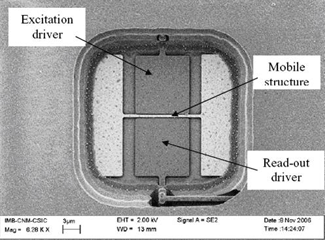Improving wireless communications

Wireless applications (cell phones, wireless LANs, etc…) have experienced an important increase last years in number of sales and also in number of applications, becoming one of the most important drivers in consumer electronics. For this reason there was a lot of effort to reduce fabrication cost of transmitter/receiver electronic systems, and also to improve their performance. The main fields of research are power consumption reduction (that would lead to longer battery life) and area reduction that would lead to more compact systems and therefore lower fabrication costs.
A family of devices that would allow the improvement of power consumption and an important area reduction are the microelectromechanical systems (MEMS), mechanical devices of micrometric size. Inside MEMS, one of the most interesting are those that can be fabricated in a CMOS commercial technology (also known as CMOS-MEMS), due to the inclusion of the mechanical devices with electronic circuitry that composes every RF transmitter/receiver.
In this work, a simple mechanical structure fabricated in a CMOS standard process together with an amplifier to amplify the output signal is studied as a one of the key elements in RF receivers/transmitters: the mixer. This mixer moves the high frequency signal to a low signal to be processed (in the case of the receiver), and the low frequency signal to a high frequency one (in the case or the transmitter).
Due to its properties, the MEMS is capable to perform the function of a mixer with smaller areas (compared with a circuit designed mixer) and zero power consumption.
First image shows a MEMS photograph obtained with a scanning electron microscope (SEM). Mobile structure has the following dimensions: length of 13um and 350nm width.
Second image show the MEMS response when the signal is translated to lower frequencies. The maximum output signal is obtained near the resonant frequency of the mechanical structure (in this case around 22.5MHz), for input signal in the GHz range. In is also shown the variation of the resonant frequency with the variation of the applied direct current voltage (VDC).
Third image shows the MEMS working to translate signal to higher frequency (the plot was obtained considering input signals with frequencies 22MHz and 434MHz)
References
A. Uranga, J. Verd, J. L. López , J. Teva, G. Abadal, F. Torres, J. Esteve, F. Pérez-Murano i N. Barniol "Fully integrated MIXLER based on a VHF CMOS-MEMS clamped-clamped beam resonator" Electronic letters, Vol. 43, Issue.8 pages. 452-454, April 2007


